| |
 |
|
 |
| |
 |
|
| |
|
|
| |
|
|
| |
Phoenix Kobe
A lesson in Disaster Recovery:
Comments on community recovery following
the 1995 Great Hanshin Earthquake, Japan.
By S.L. Donoghue, Y.O. Yan, and R.T. Irving |
 |
|
|
|
| |
The Great Hanshin Earthquake
At 5.46 a.m. on January 17, 1995, a Richter magnitude 7.2 earthquake
struck the Kobe-Hanshin region on the southern coast of Honshu,
Japan. The epicentre was located just off the mainland, 20 km
below Awajishima (Fig. 1)
Officially named the Great Hanshin Earthquake, this event saw over
150,000 houses destroyed or burned, 320,000 residents made homeless
and 6,336 citizens killed. Kobe City lost 4,510 of it's 1.5 million
citizens, killed largely by falling debris and fires. In Kobe City's
Nagata ward, 22 separate fires, many of these infernos that started
within synthetic shoe factories, consumed over 4,000 homes and shops,
killing 600 people (Fig. 1, 2).
|
|
| |
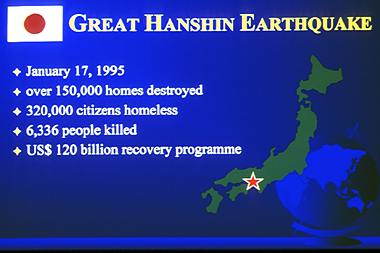
Fig
1. Impact of the 1995 Great Hanshin Earthquake
|
|
| |
Severe structural damage
to the City's rail and road networks effectively cut off the metropolitan
area from surrounding cities and severely hampered rescue attempts;
for example several collapses of the elevated Hanshin expressway
cut the City's life lines to neighbouring Osaka and Kyoto and similarly,
collapses of the Shinkansen rail supports severed the nation's arterial
rail network.
The Response Effort
 |
 |
| |
Fig
2. Kobe City's Nagata ward was razed by fires. In the background
are a few temporary homes built amongst the rubble. |
| |
|
Dramatic
scenes of the devastation reached international audiences within
hours of the earthquake. For several weeks following, news of the
rescue effort, the mounting death toll and estimates of escalating
economic loss dominated world media reports, prompting not only
numerous offers of international aid, but also considerable criticism
over what was considered to have been an extremely poor government
led disaster response and handling of the crisis.
Additional unforeseen problems compounded the loss. Traffic jams,
caused by residents attempting to flee Kobe City, and the collapse
of the City's road and rail infrastructure, only added to the confusion
and hindered the movement of emergency vehicles, including, somewhat
late in the day, Japanese Military units from nearby bases.
|
|
| |
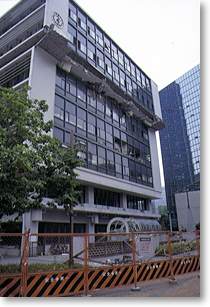 |
|
Fig
3. Structural damage to City Hall, Kobe City. Note the collapse
of one floor.
|
|
| |
 |
Power
failures severely hampered treatment of the injured lucky enough
to have made it to the City's hospitals, and also rendered many
of the City's fire cistern water pumps temporarily inoperable. Many
fires were thus left unattended. To complicate matters further,
a decision to temporarily restore electricity to affected areas
and thus households in which electrical appliances had toppled over
in the earthquake resulted in many new fires.
Serious
shortcomings in the rescue effort soon became apparent. While, for
many years, residents of the Kanto region have been aware of the
imminent occurrence of a 'big one', those in the Hanshin area were
complacent to the threat of a major earthquake. Disorganised and
confused relief workers tried the best they could to minimise further
loss of life. Clearly, however, the response plan had been hopelessly
flawed from the very outset. Confusion over where the responsibility
lay for co-ordinating a response, the limited co-ordination that
existed between rescue services in neighbouring jurisdictions, a
lack of overall emergency preparedness, and limited availability
of resources severely hampered the rescue effort and left the residents
of the Hanshin region largely helpless and struggling to cope with
the enormity of their loss. Just over half of the total casualties
(3,266 residents of Kobe City) of the region died immediately, 1,397
within 6 hours; and a total of 5,047 in the first 24 hours. Had
the response been properly planned, many hundreds, if not thousands
of lives, probably would have been spared.
|
|
| |
Community
Recovery
 |
 |
| |
Fig
4. Close-up view of the collapsed floor. |
| |
|
Following
severe criticism of the response effort, government authorities
were determined to improve public and international perceptions
of their disaster management efforts, and consequently they swiftly
implemented projects to (a) restore the transport networks (b) demolish
damaged structures and remove debris (c) provide housing for the
homeless, and (d) distribute relief aid. The overall aim being to
return the community to a degree of normalcy within the shortest
possible time period. To this end all levels (national, prefectural
and local) of government were involved in the recovery effort (Fig.3,
4, 5).
Within
Japan itself, the first official responses came from the local (municipal)
governments who each devised their own community-specific plans
for rebuilding.
|
|
| |
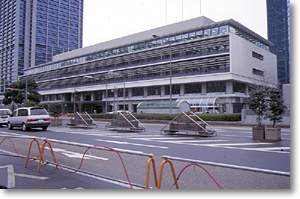 |

|
Fig.
5. The damaged City Hall was demolished and a new Hall now stands
in its place. Note the structure has fewer floors!
|
|
| |
|
By March
1995, 17 renewal plans had been submitted. These plans were finally
embraced at prefectural level with the adoption of Kobe City's Phoenix
Plan, a $US 120 billion blueprint for rebuilding its many
communities affected by the earthquake (Fig. 6, 7).
Under this plan, 'a sparkling new city' would stand in the ashes of
Kobe. A city highly attractive to new businesses and fully earthquake-proofed.
Old and congested community areas would be redeveloped into 'showpieces'
of modern living, with wider roads, bigger parks and recreational
facilities, high rise apartment blocks, multi-cultural shopping and
residential areas, and new industrial and commercial developments.
Three aspects of recovery, and three clear priorities are identifiable.
First to be addressed were areas of national importance, these being
the major transportation links and port facilities. The second and
third priorities were, respectively, redevelopment of the 17 designated
areas, and restoration of urban areas outside of these. |
|
| |
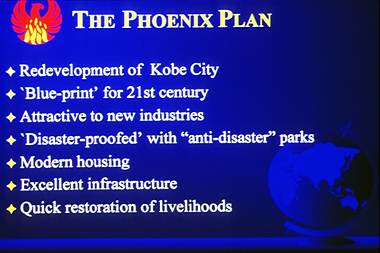
Fig.
6 The objectives of Kobe City's Phoenix Plan
|
|
| |
 |
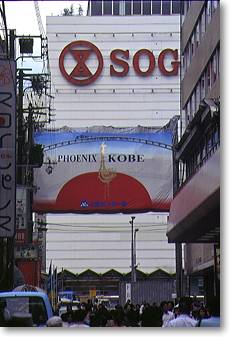 |
| |
Fig.7
Banner advertising the Phoenix Plan to Kobe City residents.
|
| |
|
The
Phoenix Plan presents
as a wholesome picture of recovery for the Hanshin area. In
reality, however, the Plan has actually hindered recovery in many
local communities,
where the restoration of homes and livelihoods should have been a
priority. Residents describe a very different picture of actual recovery
to that presented by the government officials. Recovery at community
level has, in fact, been a long, slow, and frustrating process. Why?
The answer to this question is a complicated one, involving many issues
(Fig. 8). We can identify a number of factors that have collectively
aggravated this situation, but the major underlying reason for this
unprecedented slow recovery is government intervention, i.e. government-imposed
redevelopment plans. To demonstrate, we can look briefly at the problems
in two communities, Shinnagata and Kotoen. These two communities showed
contrasting characteristics of earthquake-related damage, and partly,
as a consequence of this, local government adopted different recovery
approaches.
|
|
| |
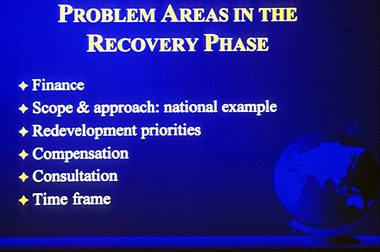
Fig.8 Why the recovery programmes did not adequately address community
recovery.
|
|
| |
In
Kotoen, although numerous homes suffered substantial damage, most
escaped with only slight damage (typically loss of roof tiles and
cracked walls) and so did not warrant demolition. Much of the housing
in Kotoen was 'modern', built in the 1970's or later, and built
to the more stringent, revised building codes of that time.
 |

|
Fig.
9 A typical example of an old, pre-war wooden house which collapsed
as a result of shaking and added stress from the weight of the
clay-tile roof.
|
|
| |
|
As a result,
residents of Kotoen were largely left to plan their own redevelopment.
Damage to homes was assessed by government agencies, and residents
were paid compensation according to the degree of damage suffered.
If the structure was considered 'repairable', owners were allowed
to rebuild at will. Property owners were therefore able to rebuild
their community, to the same standards and style as existed before
the earthquake. Even so, serious problems emerged. Many property owners
held mortgages on their properties, and for those who lost their homes,
they were now faced with paying off their existing mortgage, on a
property that no longer existed, and raising sufficient funds to buy
a new home. The amount of monetary compensation received to help them
rebuild was considered by many to be 'insulting'. Never
the less, residents of Kotoen were given the freedom to rebuild, and
there were no government-imposed plans for redevelopment of their
community.
|
|
| |
In
Shinnagata, the majority of structures were old (pre-war) wooden
buildings (Fig. 9). Most structures collapsed under the weight of
the heavy clay roof tiles characteristic of homes of that era. Others
were razed by fires, which quickly spread, from house to house in
the cramped pre-war urban environment. Fire-fighters had at best
two hours water supply with which to fight the fires due to earthquake-induced
rupturing of underground water cisterns and rupturing of more than
200 fire hoses by passing vehicles. Few homes escaped destruction.
 |
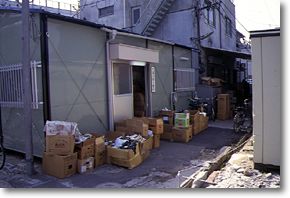 |
| |
Fig
10. A temporary pre-fabricated structure being used as a manufacturing
shop for synthetic shoes, in Nagata Ward, Kobe City. |
| |
|
Within
weeks of the earthquake, plans for rebuilding Shinnagata had been
submitted to government. By
early March, 1995, government approval was given to city planners
for a 'wholesale' redevelopment of the area. What
was left of the old pre-war housing would be demolished, and multi-storey
concrete apartment blocks would replace them. The traditional corner
stores would be replaced by neon-lit supermarkets and shopping plazas.
Residents who had lived in low-cost housing would have to buy into
expensive apartment complexes, and be forced to relocate their family
home to a new area. They would be separated from friends and neighbours,
and would be allocated housing by lottery.
The traditional shoe factories (Fig. 10), small single-story
manufacturing shops, would all be relocated into one central complex.
The relocation would, for many, result in a loss of their traditional
clientele, and generate competition amongst 'old friends' in the industry.
The traditional coffee shops and corner stores would not be able to
compete with supermarket chain prices and would lose clientele and
eventually be forced to close.
|
|
| |
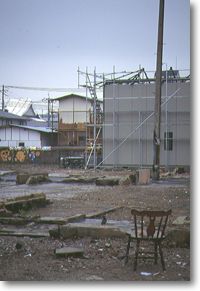 |
|
| Fig.
11. Large areas of cleared land, such as this, characterised
Nagata Ward, following the earthquake and fires that razed 40%
of all structures. In the background are temporary homes, which
must eventually be torn down to make way for new developments.
|
|
| |
|
There
was an outcry, with residents calling 'foul play'. The speed with
which the plans had been approved stunned the community. Government
officials had not consulted local residents about their proposals
for redevelopment, and were largely unsympathetic to their concerns.
Compounding the problem was the amount of money the Government was
then investing into major infrastructural projects. Kobe residents
were particularly vocal regarding the Transportation Ministry's hasty
plans to build a new airport off Kobe's Port Island, at the expense
of getting peoples lives back together in the quake ravaged city.
Interviews
with government officials and city planners then revealed that plans
for urban redevelopment of Shinnagata already existed, and had existed
for some time. Indeed, all communities earmarked for redevelopment
in the Phoenix Plan correlated exactly with those areas defined in
the earlier Kobe City urban renewal plans. Shinnagata had for several
years been designated a redevelopment zone because it had long suffered
from inner city problems including aged and deteriorated buildings,
congested streets, and lack of open spaces, and because it contained
incompatible mixed land uses e.g. interwoven residential and
industrial sectors.
Did the Great Hanshin Earthquake then provide planners with a perfect
opportunity to implement these urban renewal plans, and was the Phoenix
Plan really a plan for community "recovery" or a means of
implementing existing plans? What was the motive behind the redevelopment?
It is our opinion that the Government's principal interest was urban
renewal.
|
|
| |
 |
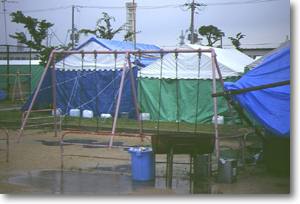 |
| |
Fig
12. Residents who lost their homes in the earthquake lived for
many months, and some for up to a year, in tents erected in
children's playgrounds and parks across the City. |
| |
|
Residents
were outraged at the lack of consultation and likely impact that the
plans would have on their lives. Resident's Associations were quickly
formed for the purpose of hearing and collecting resident's opinions
on the proposed plans, and forwarding their objections to government.
As the pressure for answers mounted, government officials were forced
to the table to negotiate the redevelopment, and a multitude of related
issues such as compensation and employment opportunities. As a result
of the introduction of the plans, residents were not permitted to
build any permanent structures, and indeed had to apply for a permit
to build temporary dwellings (Fig. 11), with the understanding
that any
structure would have to be demolished within a five year period, at
the owners expense, to make way for urban redevelopment. Court cases
loomed because insurance companies refused to pay for houses lost
to the fires. Those who held fire insurance were told that the fires
were a result of an earthquake, and therefore they would need earthquake
insurance in order to receive payment. Those that held earthquake
insurance were told that fires destroyed their homes, not the shaking
from the earthquake. They too were not paid. |
|
| |
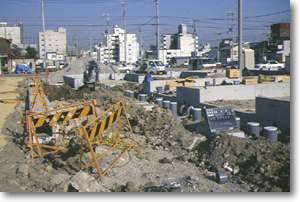 |
|
Fig.
13. Re-building Nagata. Permanent structures are now allowed
to be built.
|
|
|
 |
Nearly
all of Shinnagata's residents were thus forced to remain living
in temporary shelters (Fig. 12) and pre-fabricated while government
negotiated the redevelopment. Locals conducted their business from
pre-fabricated fibreglass 'boxes' laid out the along buckled sidewalks.
Both parties became locked in debate for almost two years following
the earthquake. Many residents chose to leave the area having given
up hope of ever being able to rebuild a life there.
Finally, in March 1997, three years after the earthquake, agreement
was reached between the parties, and approval was given for redevelopment
work to begin (Fig. 13).
|
|
| |
 |
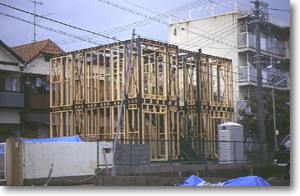 |
| |
Fig
14. Homes in Kobe City are being built to new designs and safety
codes. Residents of Kobe hope never to experience such an earthquake
again. |
| |
|
There
will be high-rise complexes, but fewer than planned. Roads will have
to be widened to satisfy regulations concerning building height and
road width, and residents will have to relocate as land is consumed
for apartment developments. Land zoning will see areas set aside for
residential, commercial, light industrial and recreational (including
expanded parkland) uses. The revised plans primarily aim to create
a spacious living environment with a new road layout, wider tree-lined
roads, and low-rise housing. To address future safety, there will
also be a major redesigning of the underground water storage facilities
used for emergency fire fighting.
New
low-rise homes are being built using wood and/or steel (Fig. 14) on
concrete foundations. They incorporate new seismic resistant structural
features. Many of these homes have been built on a Canadian model,
and a post-earthquake feature has been the employment of many Canadian
nationals for the purpose of building of these 'earthquake-proof'
homes. |
|
| |
One
obvious impact of the redevelopment has been that the face of the
Japanese urban landscape has now changed. Gone are the bonsai gardens,
ceramic roof tops and smoky, dimly lit wooden coffee shops. Shinnagata
no longer 'feels' truly Japanese.
A memorial
wall to the earthquake will be built in Shinnagata. It will serve
as a reminder of the many thousands of friends and family members
lost. Equally important, it will be a pertinent reminder to government
of the importance of developing sound disaster-management plans, especially
disaster response and recovery plans. |
|
| |
References cited:
- Kobe Shinbun S.g. Shuppan Sentaa, 1995: The Hanshin-Awaji earthquake:
a collection of air photographs - a record of events five days
after the earthquake, January 17-21. Kobe Newspapers Group Publishing
Centre.
- National Land Agency 1995: White paper on disaster prevention
(In Japanese).
- Nishimura, K. 1995: Nothing Shakes. Look Japan (May) 4-10.
- Rafferty, K. 1995: Eastern Express 1 March 1995
- Sait_, T. 1995: The Road to Recovery. Look Japan (May)
14-15.
- The Daily Yomiuri :2 Dec. 1995, 4 December 1995, 31 December
1995, 19 February 1997, 3 March 1997.
- The Southern Hyogo Prefecture Earthquake Dammage Assessment
Support Committee 1995: A collection of aerial photographs (with
local areas labeled) of region struck by the Hanshin Earthquake
. Nikkei Osaka Pr. Incorporated.
- Walsh, J. 1996: Kobe, One Year Later. Time (January 22)
14-19
|
|
| |
|
|
|
|
















